Challenge 4
Here you can see Dídac’s and Pippa's and my repository about the sensing ball, SFEEL.

This challenge our task was to “Design and make something that can help your research or the exhibition of it on MDEFest” and we had to do our project based on the knowledge from the previous classes, in other words just go wild and use every opportunity you have.
So we went wild: we 3D printed, we laser cut, we did thousands of inputs with sensors and microphones, and almost thousands of outputs on P5, such as motion detecting drawing, we molded and casted: biomaterials and hydrocal, we used the cnc and we even felted wool (which should be a weekly task somewhere in the middle of the year to meditate.)

This analogy of the project was born by two accidents, one that we had the persentation of the micro challenge on the same day, when we have our regular Friday Montessori workshop with Pippa, about materiality and spatial awareness. And by the accident that Dídac wrote down the same scenario with the same artefact as us on the Miro board.
So the ideation process was pretty quick, in other words it was non-existent, we just jumped into the middle and started designing our sensory ball and it’s part, while designing the inputs and outputs for it.

Our concept was a gamified audiovisual system, to capture different perception of different environments. Capturing movements, sounds and sensing of materials. Visualising the movements of the body in a space, the connection with different materials in the natural or built environment.

And why?
To help to understand how kids with heightened sensitivities (the ones who are actually affected by the built and natural environment around us) understand the environment around them, how they move around in spaces and what kind of materials are they connected to the most in different environments. And turn the data back to create better spaces which would support their tactile and imaginative development.
To help people to understand more their surroundings and how they move around in spaces, to connect them to different materialities and understand their heightened sensitivities and create and audiovisual experience from their perceptions.
Based on our research areas, such as Pippa’s interest in material sensing and the effects of using natural or bio-remediating materials on people’s and kids behaviours, Dídac’s interest in different kind of sensory systems and how these can be embodied and my interest on the effect of our built and natural environment on kids and their kind of reality in these.

